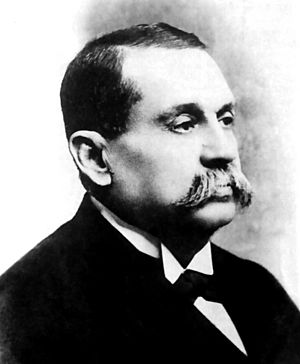Guillermo Billinghurst facts for kids
Quick facts for kids
Guillermo Billinghurst
|
|
|---|---|
 |
|
| President of Peru | |
| In office September 24, 1912 – February 4, 1914 |
|
| Prime Minister | Elías Malpartida Enrique Varela Vidaurre Federico Luna y Peralta Aurelio Sousa Matute |
| Vice President | Roberto Leguía Miguel Echenique |
| Preceded by | Augusto B. Leguía |
| Succeeded by | Óscar R. Benavides |
| President of the Senate | |
| In office 28 July 1896 – 28 July 1897 |
|
| Preceded by | Manuel Pablo Olaechea |
| Succeeded by | Manuel Candamo |
| First Vice President of Peru | |
| In office 8 September 1895 – 8 September 1899 |
|
| President | Nicolás de Piérola |
| Preceded by | Vacant (Last held by César Canevaro in 1895) |
| Succeeded by | Isaac Alzamora |
| Senator from Tacna | |
| In office 28 July 1895 – 28 July 1899 |
|
| Preceded by | Manuel Pablo Olaechea |
| Succeeded by | Manuel Candamo |
| Member of the Chamber of Deputies | |
| In office 28 July 1878 – 28 July 1880 |
|
| Constituency | Tarapacá Province |
| Personal details | |
| Born |
Guillermo Enrique Billinghurst Angulo
July 27, 1851 Arica, Peru |
| Died | June 28, 1915 (aged 63) Iquique, Chile |
| Political party | Democratic Party of Peru |
| Relatives | Susana Ferrari Billinghurst (cousin) |
| Profession | Entrepreneur |
Guillermo Enrique Billinghurst Angulo (born in Arica, Peru, on July 27, 1851 – died in Iquique, Chile, on June 28, 1915) was an important Peruvian politician. He became the 31st President of Peru, serving from 1912 to 1914. He took over from Augusto B. Leguía. Billinghurst had some English family background. His last name, Billinghurst, comes from a place in Sussex, England.
During his time as president, Billinghurst had many disagreements with the Peruvian Congress. These arguments were about new laws he wanted to pass, especially those that would help workers. They also argued about how to solve a border problem with Chile over the Tacna and Arica regions.
These conflicts led to a military uprising. People who didn't like Billinghurst's government used the military to remove him from power. After this, Billinghurst was sent away to Chile, where he passed away a short time later.
Contents
Early Life and Political Beginnings
Guillermo Billinghurst was part of a political group called the Civilistas. At the time, this group was seen as responsible for bringing stability and economic growth to Peru. However, their actions also started big social changes that would later reshape Peru's politics.
Billinghurst served as the First Vice President of Peru under President Nicolás de Piérola from 1895 to 1899. During this time, he worked on finding a solution to the land dispute with Chile over the Tacna and Arica areas.
In 1898, Billinghurst and Chile's Minister of Foreign Affairs, Raimundo Silva Cruz, signed an agreement. This agreement suggested that before people in Tacna and Arica could vote on which country they wanted to belong to, the Queen of Spain, María Cristina de Habsburgo-Lorena, would decide how the vote should happen.
However, this agreement, known as the Protocol of Billinghurst-Latorre, was not approved by Chile's government. Because of this, Peru and Chile stopped having diplomatic relations in 1901.
Billinghurst also served as the President of the Senate from 1896 to 1897. This meant he was in charge of the Senate, a part of Peru's government.
Becoming President: The 1912 Elections
The elections in 1912 were very exciting and intense. This period was known as the Aristocratic Republic, a name given because many people in power came from Peru's wealthy families. The Civilist Party supported Antero Aspíllaga, a very traditional member of their party. His opponents claimed he was born in Chile and therefore not fit to be president.
However, the Civilistas found it hard to control the new social forces that their own policies had created. This became clear in 1912. Guillermo Billinghurst, a rich businessman and former mayor of Lima, was known for his reform ideas and his popularity with ordinary people. He managed to organize a general strike. This strike helped block the official Civilista candidate from winning and forced Congress to elect Billinghurst as president instead.
Key Actions as President
One of the most important things Billinghurst did as president was to create a law that set the Eight-hour day for workers in Peru. This meant that workers could only be required to work eight hours a day, which was a big step forward for workers' rights.
In 1914, the Congress started a process called impeachment against Billinghurst. This is when a government body tries to remove a public official from office. In response, Billinghurst threatened to give weapons to workers and forcefully close Congress.
End of Presidency
Guillermo Billinghurst was removed from power on February 4, 1914. This happened in a military coup, which is when the military takes control of the government by force. The coup was led by Colonel Óscar R. Benavides, along with Javier and Manuel Prado, and other conservative members of the Civilista Party.
Later, while in exile, Billinghurst said that the young Prado had explained the reasons for the coup to him. Prado told him that everyone involved recognized Billinghurst's patriotism, honesty, and ability to govern. However, they believed his biggest mistake was the direction his internal policies were taking the country. Prado also mentioned that the sons of the former president Prado felt they needed to "clean his father's memory."
See also
 In Spanish: Guillermo Billinghurst para niños
In Spanish: Guillermo Billinghurst para niños

